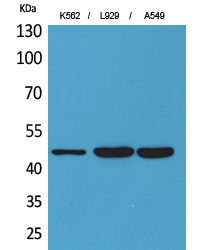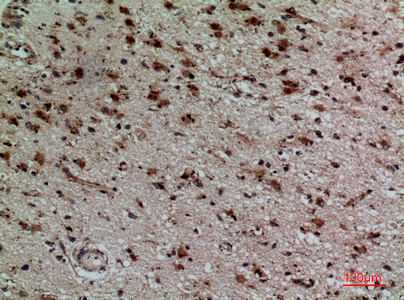CD158z Polyclonal Antibody
- Catalog No.:YT5273
- Applications:WB;IHC;IF;ELISA
- Reactivity:Human
- Target:
- CD158z
- Fields:
- >>Antigen processing and presentation;>>Natural killer cell mediated cytotoxicity;>>Graft-versus-host disease
- Gene Name:
- KIR3DL3
- Protein Name:
- Killer cell immunoglobulin-like receptor 3DL3
- Human Gene Id:
- 100133046
- Human Swiss Prot No:
- Q8N743
- Immunogen:
- The antiserum was produced against synthesized peptide derived from the Internal region of human KIR3DL3. AA range:231-280
- Specificity:
- CD158z Polyclonal Antibody detects endogenous levels of CD158z protein.
- Formulation:
- Liquid in PBS containing 50% glycerol, 0.5% BSA and 0.02% sodium azide.
- Source:
- Polyclonal, Rabbit,IgG
- Dilution:
- WB 1:500 - 1:2000. IHC: 1:100-300 ELISA: 1:20000.. IF 1:50-200
- Purification:
- The antibody was affinity-purified from rabbit antiserum by affinity-chromatography using epitope-specific immunogen.
- Concentration:
- 1 mg/ml
- Storage Stability:
- -15°C to -25°C/1 year(Do not lower than -25°C)
- Other Name:
- KIR3DL3;CD158Z;KIR3DL7;KIRC1;Killer cell immunoglobulin-like receptor 3DL3;CD158 antigen-like family member Z;Killer cell inhibitory receptor 1;CD158z
- Observed Band(KD):
- 45kD
- Background:
- killer cell immunoglobulin like receptor, three Ig domains and long cytoplasmic tail 3(KIR3DL3) Homo sapiens Killer cell immunoglobulin-like receptors (KIRs) are transmembrane glycoproteins expressed by natural killer cells and subsets of T cells. The KIR genes are polymorphic and highly homologous and they are found in a cluster on chromosome 19q13.4 within the 1 Mb leukocyte receptor complex (LRC). The gene content of the KIR gene cluster varies among haplotypes, although several "framework" genes are found in all haplotypes (KIR3DL3, KIR3DP1, KIR3DL4, KIR3DL2). The KIR proteins are classified by the number of extracellular immunoglobulin domains (2D or 3D) and by whether they have a long (L) or short (S) cytoplasmic domain. KIR proteins with the long cytoplasmic domain transduce inhibitory signals upon ligand binding via an immune tyrosine-based inhibitory motif (ITIM), while KIR proteins with the short cytoplasmic domain lack the
- Function:
- function:Receptor on natural killer cells. May inhibit the activity of NK cells thus preventing cell lysis.,similarity:Belongs to the immunoglobulin superfamily.,similarity:Contains 3 Ig-like C2-type (immunoglobulin-like) domains.,
- Subcellular Location:
- Cell membrane; Single-pass type I membrane protein.
- Expression:
- Peripheral blood,
- June 19-2018
- WESTERN IMMUNOBLOTTING PROTOCOL
- June 19-2018
- IMMUNOHISTOCHEMISTRY-PARAFFIN PROTOCOL
- June 19-2018
- IMMUNOFLUORESCENCE PROTOCOL
- September 08-2020
- FLOW-CYTOMEYRT-PROTOCOL
- May 20-2022
- Cell-Based ELISA│解您多样本WB检测之困扰
- July 13-2018
- CELL-BASED-ELISA-PROTOCOL-FOR-ACETYL-PROTEIN
- July 13-2018
- CELL-BASED-ELISA-PROTOCOL-FOR-PHOSPHO-PROTEIN
- July 13-2018
- Antibody-FAQs
- Products Images

- Western Blot analysis of K562, L929, A549 cells using CD158z Polyclonal Antibody. Secondary antibody(catalog#:RS0002) was diluted at 1:20000

- Immunohistochemical analysis of paraffin-embedded human-brain, antibody was diluted at 1:100

- Western blot analysis of lysate from K562 cells, using KIR3DL3 Antibody.



